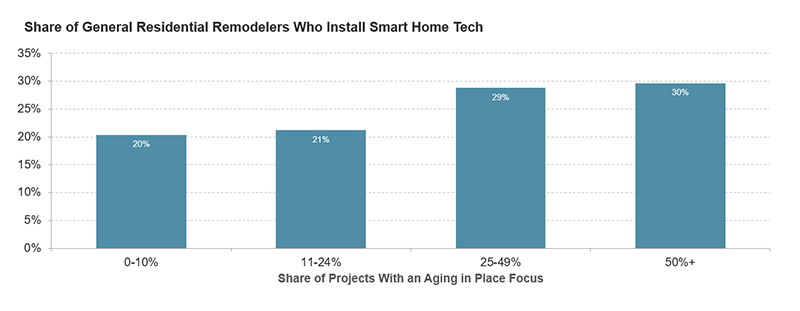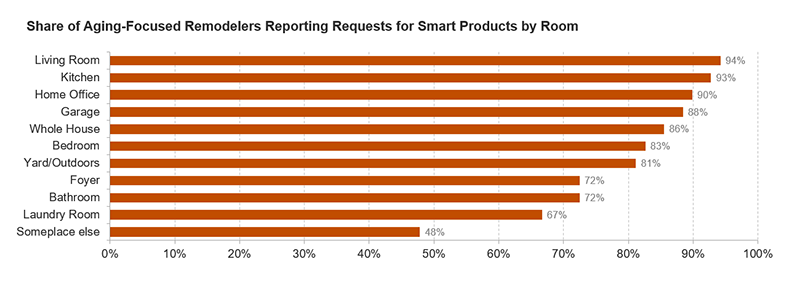Remodels that Include Home Automation Can Help Older Adults Age in Place
Over the past 20 years, the number of homeowners age 55 and over has grown dramatically from 26 million to more than 42 million, increasing their share of all owners to almost 55 percent, according to our latest Improving America’s Housing report. Home improvement spending among these households grew by 152 percent, accounting for half of all remodeling spending. As the US population continues to age, demand for residential remodeling projects will increasingly come from this older market segment.
A variety of residential remodeling projects can be especially helpful for older homeowners. Some of our earlier research on home remodeling and aging in place focused on the structural modifications required for basic home accessibility, such as no-step entry, extra-wide doorways and halls, and single-floor living spaces. Another type of home modification that is receiving increasing attention is smart home technology. Many smart or connected products – which are wirelessly connected to the internet or to other products in the home and are remotely accessible with a smart phone, tablet, or computer – such as thermostats, lighting, appliances, electronic locks, etc. improve the livability of a home for persons with mobility difficulties and therefore complement traditional accessibility modifications. Smart home products and systems are being considered as part of homeowners’ aging-in-place strategies, either on their own or in combination with traditional remodeling projects.
A recent contractor survey we conducted with The Farnsworth Group about smart tech attitudes and usage found that, among general remodelers who install any amount of smart tech products, a significant share are “specializing” in home improvements for aging in place. Roughly one in three of these remodelers (30 percent) report that at least half of their projects have an aging-in-place focus (Figure 1). For the purposes of the survey, aging in place refers to a person who lives and ages in their residence for as long as they are able. These “aging-focused” remodelers are attuned to the benefits of home automation, with 93 percent reporting they typically include smart home products or systems when working with owners to implement an aging-in-place strategy.
Figure 1. A Large Share of Remodelers Report That the Majority of Projects Focus on Aging in Place
Notes: The survey had a sample size of 250 participants. “Aging in place” refers to a person who lives and ages in their residence for as long as they are able to.
Source: JCHS tabulations of Harvard JCHS-The Farnsworth Group, Smart Tech Attitudes and Usage Among Remodelers Survey, Fall 2019.
By far, the most commonly installed home automation products or systems included in aging-in-place renovation projects are for safety and security and climate control (Figure 2). Ninety-four percent of aging-focused remodelers generally include smart safety and security products or systems in aging-in-place projects, such as security cameras and lighting, video doorbells, electronic locks, smart hazard detectors, and alarms. And 83 percent of aging-focused remodelers include smart climate control products in aging-in-place retrofits, such as connected thermostats, fans, air conditioners, and radiator valves.
Figure 2. Safety & Security and Climate Control Top List of Home Automation Systems Installed as Part of Aging-in-Place Strategy
Notes: The survey had a sample size of 250 participants. Aging-focused remodelers are general residential remodelers reporting 50% or more of projects with an aging in place focus.
Source: JCHS tabulations of Harvard JCHS-The Farnsworth Group, Smart Tech Attitudes and Usage Among Remodelers Survey, Fall 2019.
These results align with smart products that are generally recommended for older homeowners. In their research, The Hartford and the MIT AgeLab’s expert panel identified ten smart tech products that “can make life easier, help with home maintenance, and enhance safety and security” for older homeowners, including products like smart smoke and carbon monoxide detectors, keyless entry, and automatic lighting. The Hartford and MIT AgeLab also named ten smart home technologies that would be beneficial to older homeowners with health conditions, including telehealth systems, medical and medication management systems, and smart fall detection systems. Yet, only 26 percent of aging-focused remodelers report generally including smart health or fitness monitoring products, such as smart beds, sleep sensors, or smart floorings. This relatively low share could be due to many factors, including homeowners’ lack of familiarity with these newer-to-market products and high product prices.
Figure 3. Remodelers Focused on Aging in Place Most Commonly Receive Requests for Smart Tech in Living Rooms, Kitchens, and Home Offices
Notes: The survey had a sample size of 250 participants. Aging-focused remodelers are general residential remodelers reporting 50% or more of projects with an aging in place focus.
Source: JCHS tabulations of Harvard JCHS-The Farnsworth Group, Smart Tech Attitudes and Usage Among Remodelers Survey, Fall 2019.
The top rooms for home automation installations are living rooms and kitchens, with over 90 percent of aging-focused remodelers receiving requests for smart products in these two rooms (Figure 3). Interestingly, while 83 percent receive requests for smart tech in the bedroom and 72 percent in the bathroom—areas of the home where accessibility modifications might be more critical—aging-focused remodelers are more often asked to install home automation as part of renovations to home offices, garages, and whole houses (86-90 percent). Moreover, health and fitness tech was last on the list of products or systems typcially included in aging-in-place projects by remodelers with an aging focus to their work. This suggests that when remodeling, older owners are thinking about home automation and aging in place in much broader terms than just accessibility. For remodelers, there is a large opportunity to use smart tech to help older homeowners, especially those with health conditions, successfully age in place.
Further analysis of data from our survey on smart tech attitudes and usage among general remodelers, and the potential of home automation for supporting aging in place, will be compiled in a forthcoming research brief.




